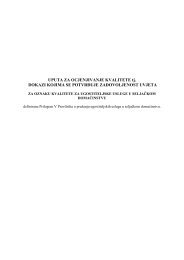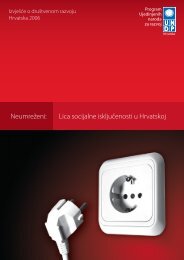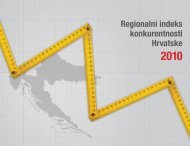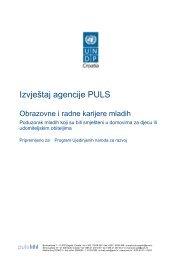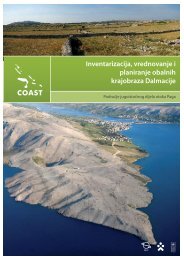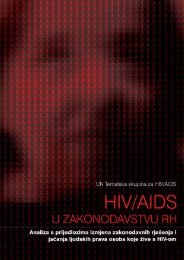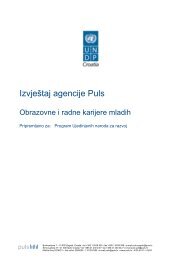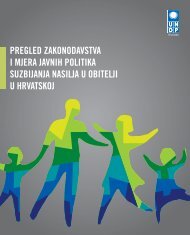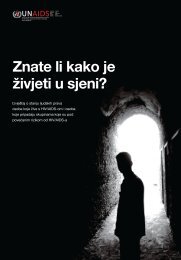WEB engleska verzija end.indd - UNDP Croatia
WEB engleska verzija end.indd - UNDP Croatia
WEB engleska verzija end.indd - UNDP Croatia
- No tags were found...
Create successful ePaper yourself
Turn your PDF publications into a flip-book with our unique Google optimized e-Paper software.
THE SOCIALLY EXCLUDEDCHAPTER 3community). Building mechanisms of political responsibilityin the implementation of minority rights andthe elimination of ‘hate speech’ lags behind the positivechanges that have occurred in the public domain.Regarding the Roma in particular, reports commissionedby national and foreign organisations pointto violations of rights and discrimination against theRoma in various aspects of civil, social and politicallife. 56 However, discrimination in education againstthe Roma children is most evident and has resultedin complaints filed to the European Court of HumanRights. More attention is also being paid to the discriminationand violation of rights for Roma women,which has been referred to as multi-dimensional discrimination.Roma women are discriminated againstwithin their family, where a predominantly patriarchalstructure prevails; they are also discriminated againstby the majority population based on their g<strong>end</strong>erand their ethnicity.3.2.2 Access to Social Services‘We’ve got confidence and they do try to go theextra mile, but they cannot give us as much helpus as we need. (Participant of the focus group, Sisak,<strong>UNDP</strong>, 2006b)According to the official data, the Roma account forless than 1% of the total population, however theyaccount for 13.56% of the recipients of social assistance.Most of the social welfare services they use arefor financial assistance. It seems that there are twobasic tensions between the representatives of socialwelfare and the Roma as the recipients of their services.57 Both tensions concern a degree of confidencein the system which is frequently connected withsocial workers understanding of the accumulation ofunfavourable life circumstances and the use of discretionaryjudgement in circumventing stringent rules. Asstated by a focus group participant, “[the] social welfarecentre prohibits us from having vehicles, but if we didnot have them, we could not survive.” This points to theneed to have the Centres of Social Welfare (CSW) adopta more active approach in customizing individual plansfor recipients in which the financial assistance wouldhave the form of temporary assistance. There is also aneed to build closer connections between CSW, the<strong>Croatia</strong>n Employment Bureau, and the private sector.The Serbs do not object to their level of access to socialwelfare, it is the families that were separated duringtheir period as refugees, whose children have grownup and established a new life in the areas where theyused to be refugees (Serbia, BiH), that have problems.The social problems of families who have youngermembers are somewhat mitigated by family solidarityand older members who have the right to a pension,which is used to support the entire family.3.2.3 Access to HealthcareThe right to health is guaranteed by the <strong>Croatia</strong>nConstitution and a number of statutory provisions onhealth insurance and on the right to health insurancefor persons who dep<strong>end</strong> on the active members oftheir families. However, the legislation is closely tiedwith specific time limits, and the failure to comply withthe time limits results in a loss of the right to healthinsurance and access to health services. Childrenunder 14 who have registered residence in the territoryof <strong>Croatia</strong>, children under 18 att<strong>end</strong>ing schoolon a full time basis, as well as pregnant women andwomen who have recently delivered, have the rightto free health insurance. It seems that most Romawho meet these conditions make use of their rightsto health protection. However, in the case of otheradults, many go without health insurance. In the Cityof Zagreb, 58 40% of adult members of the Roma minoritydo not have health insurance, including mostadult members of the Roma who live in the biggestsettlement in the County of Sisak-Moslavina.Research 59 produced by Roma associations emphasizesthe young age of the Roma population; in56 Amnesty International, ERRC, CHC and the G<strong>end</strong>er Equality Ombudsman.57 <strong>UNDP</strong> (2006b). Research on social exclusion in <strong>Croatia</strong>: groups with increased risk of social exclusion - focus groups. <strong>UNDP</strong>, Zagreb,<strong>Croatia</strong>58 City programme of activities and measures to improve the standards of development and the environment at locations settled by theRoma (2005), document of the City Institute for Spatial Planning, City of Zagreb59 Pokos, N. (2005): Demografska analiza Roma na temelju statističkih podataka, pp. 42-43 in Kako žive hrvatski Romi?45



